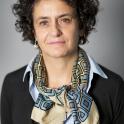Teams
-

-

-

-

Nadia Bahi-Buisson
>> Reference Center for rare diseases
Intellectual disabilities of rare causes – RETT -

-

-
Michel Zérah
>> Reference center for rare diseases
Rares vertebral and spinal malformations (C-MAVEM)
Filière Neurosphinx
Associated with the European Reference Network (ERN) eUROGEN
Imagine's Offers
-
Malformation of cortical development
TubulinopathiesGenotype PhenotypeTargetsTherapeuticsClinical trialsDyneinopathiesGenotype PhenotypeTargetsTherapeuticsClinical trialsLissencephaly - Agyria Pachygyria syndromesGenotype PhenotypeTargetsTherapeuticsClinical trialsMegalencephaliesGenotype PhenotypeTargetsTherapeuticsClinical trialsMicrocephaliesGenotype PhenotypeTargetsTherapeuticsClinical trialsPolymicrogyriaGenotype PhenotypeTargetsTherapeuticsClinical trialsHeterotopiaGenotype PhenotypeTargetsTherapeuticsClinical trialsOther rare cortical malformationsGenotype Phenotype-
Cohorts
Please, contact us
-
Patient samples
Please, contact us
Targets-
In vitro models
Please, contact us
-
In vivo models
Please, contact us
-
Specific targets
Please, contact us
TherapeuticsClinical trialsNeurodevelopmental disorders
Rett syndromeGenotype Phenotype-
Cohorts
> 200 patients
Targets-
Specific targets
MECP2
TherapeuticsClinical trialsFOXG1 syndromeGenotype Phenotype-
Cohorts
Please, contact us
Targets-
Specific targets
FOXG1
TherapeuticsClinical trialsCDKL5 deficient disordersGenotype Phenotype-
Cohorts
Please, contact us
Targets-
In vivo models
CDKL5
TherapeuticsClinical trialsAngelman syndromeGenotype Phenotype-
Cohorts
> 50 patients
TargetsTherapeuticsClinical trialsAutism spectrum disordersGenotype Phenotype-
Cohorts
> 300 patients
TargetsTherapeutics-
Protocols/Technics
Transcranial magnetic stimulation
Clinical trialsNon-syndromic intellectual disabilitiesGenotype Phenotype-
Cohorts
Please, contact us
TargetsTherapeuticsClinical trialsOther rare Developmental Epileptic Encephalopathies (DEEs)Genotype Phenotype-
Cohorts
Please, contact us
TargetsTherapeuticsClinical trialsCerebellar malformation
Early-onset cerebellar atrophyGenotype Phenotype-
Cohorts
> 40 patients
-
TNGS / WES / WGS*
TNGS and WES
-
Patient samples
DNA
Targets-
Specific targets
CACNA1G, other genes
TherapeuticsClinical trialsPontocerebellar hypoplasieGenotype Phenotype-
TNGS / WES / WGS*
TNGS and WES
Targets-
In vitro models
Brain organoïds
TherapeuticsClinical trialsDysphasies
DysphasiesGenotype Phenotype-
Cohorts
> 15 patients
TargetsTherapeuticsClinical trials -
-
Joubert syndrome (JS)Genotype PhenotypeTargetsTherapeuticsClinical trialsMeckel syndrome (MKS)Genotype PhenotypeTargetsTherapeuticsClinical trialsHydrolethalus syndrome (HLS)Genotype PhenotypeTargetsTherapeuticsClinical trialsCorpus Callosum malformationsGenotype PhenotypeTargetsTherapeuticsClinical trialsMalformations of cortical developmentGenotype PhenotypeTargetsTherapeuticsClinical trials
-
Dystonia and movement disordersGenotype Phenotype
-
Cohorts
Please, contact us
TargetsTherapeuticsClinical trials -
-
Neurodegeneration with brain iron accumulation (NBIA)Genotype Phenotype
-
Cohorts
10 pediatric and adult patients
-
TNGS / WES / WGS*
"Mitome" gene panel for mitochondrial diseases
-
Patient samples
Fibroblasts
Targets-
Specific targets
CRAT, REPS1, etc.
Therapeutics-
Specific biomarkers
Please, contact us
-
Patents
Methods and pharmaceutical compositions for the treatment of neurodegeneration with brain iron accumulation (WO2018115012)
Second patent (please, contact us) -
Specific therapeutic approaches
Repurposing
Clinical trialsFriedreich ataxiaGenotype Phenotype-
Cohorts
> 200 pediatric and adult patients
-
Patient samples
Fibroblasts, DNA
Targets-
Specific targets
FXN
Therapeutics-
Specific biomarkers
Please, contact us
-
Patents
Methods and pharmaceutical compositions for the treatment of neurodegeneration with brain iron accumulation (WO2018115012)
Second patent (please, contact us) -
Specific therapeutic approaches
Gene therapy
Repurposing
Clinical trialsAmyotrophic Lateral SclerosisGenotype PhenotypeTargets-
In vivo models
KO and KI zebrafish models for C9orf72, TDP-43, Fus, p62, TBK1
-
Protocols/Technics
Phenotypic characterization and drug screening platform for zebrafish (live imaging, in vivo electrophysiology recordings, and drug screening on zebrafish models)
-
Specific targets
C9orf72, TDP-43, Fus, p62, TBK1
Therapeutics-
Specific therapeutic approaches
Small molecules
Innovative treatment (confidential)
Clinical trials -
-
STING-associated vasculopathy with onset in infancy (SAVI)Genotype Phenotype
-
Cohorts
Mainly pediatric
20
-
TNGS / WES / WGS*
Interferonopathies
-
Patient samples
DNA
RNA
Serum/plasma
CSF
PBMCs
Fibroblasts
LCLs
Targets-
In vitro models
B-EBV-transformed B lymphocytes
SV40 transformed STING-patient fibroblasts
iPS cells
IFN beta promoter-reporter (GFP/RFP/Luc) cell lines
-
In vivo models
STING-KI mice (V154M CRISPR/Cas9)
-
Protocols/Technics
IFNa IFNb dosage in patients' cells supernatants, IFN signature
pSTAT3 and STING intracellular staining
pTBK1 elisa test
Apoptosis evaluation
T-reg suppression analysis
Phenotyping of T-reg CD4-/CD8-
Single-cell transcriptomics
CITE-seq protocol
Network inference analysis
-
Specific targets
TMEM173
TherapeuticsClinical trialsAicardi-Goutieres syndrome (AGS)Genotype Phenotype-
Cohorts
Mainly pediatric
>100
-
TNGS / WES / WGS*
Interferonopathies
-
Patient samples
DNA
RNA
Serum/plasma
CSF
PBMCs
Fibroblasts
LCLs
Targets-
In vitro models
HEK
HELA
THP1
-
Protocols/Technics
Singe-cell transcriptomics
CITE-seq protocol
Network inference analysis
-
Specific targets
TREX1
RNASEH2A
RNASEH2B
RNASEH2C
TherapeuticsClinical trials-
NCT
NCT02363452: phase II Pilot Clinical Trial of Reverse Transcriptase Inhibitors in Children With Aicardi-Goutières Syndrome (AGS)
-
-
Congenital disorder of glycosylationGenotype PhenotypeTargets
-
In vivo models
Cerebellum specific Srd5a3 KO
-
Specific targets
SRD5A3
TherapeuticsClinical trialsInositol phosphate metabolism and very early-onset neurodegenerationGenotype PhenotypeTargetsTherapeuticsClinical trials -
-
Early onset epileptic encephalopathies (EOEE)Genotype Phenotype
-
Cohorts
> 100 patients
TargetsTherapeuticsClinical trialsEpilepsies with migrating focal seizures in infancyGenotype Phenotype-
Cohorts
> 15 patients
TargetsTherapeuticsClinical trialsInfantile spasms syndrome (West syndrome)Genotype Phenotype-
Cohorts
Please, contact us
TargetsTherapeuticsClinical trialsDravet syndromeGenotype Phenotype-
Cohorts
> 120 patients
TargetsTherapeuticsClinical trialsMyoclonic Astatic epilepsyGenotype Phenotype-
Cohorts
> 50 patients
TargetsTherapeuticsClinical trialsLennox GastautGenotype Phenotype-
Cohorts
> 30 patients
TargetsTherapeuticsClinical trialsRasmussen encephalitisGenotype Phenotype-
Cohorts
> 15 patients
TargetsTherapeuticsClinical trialsAuto-immune encephalitisGenotype Phenotype-
Cohorts
> 50 patients
TargetsTherapeuticsClinical trialsProgressive myoclonic epilepsiesGenotype Phenotype-
Cohorts
> 15 patients
TargetsTherapeuticsClinical trialsFiresGenotype Phenotype-
Cohorts
> 10 patients
TargetsTherapeuticsClinical trialsTuberous sclerosis complex (TSC)Genotype Phenotype-
Cohorts
> 120 patients
TargetsTherapeuticsClinical trialsSturge Weber SyndromeGenotype Phenotype-
Cohorts
> 50 patients
TargetsTherapeuticsClinical trialsCortical dysplasiaGenotype Phenotype-
Cohorts
Please, contact us
TargetsTherapeuticsClinical trialsCDKL5 deficient disordersGenotype Phenotype-
Cohorts
Please, contact us
TargetsTherapeuticsClinical trialsFOXG1 syndromeGenotype Phenotype-
Cohorts
Please, contact us
TargetsTherapeuticsClinical trialsAngelman syndromeGenotype Phenotype-
Cohorts
Please, contact us
TargetsTherapeuticsClinical trialsRing chromosome 20Genotype Phenotype-
Cohorts
Please, contact us
TargetsTherapeuticsClinical trialsKCNB1 encephalopathiesGenotype Phenotype-
Cohorts
> 35 patients
TargetsTherapeuticsClinical trials -
-
Spina bifida (myelomeningocele)Genotype Phenotype
-
Cohorts
Please, contact us
TargetsTherapeuticsClinical trialsOther dysraphismsGenotype Phenotype-
Cohorts
Please, contact us
TargetsTherapeuticsClinical trials -
-
Brain MRI analysis
Neuroimaging allows to explore the anatomy of the brain. In recent decades, the accessibility of MR scanners and rapid advances in the development of MRI sequences have provided a large amount of data. Analyzing these data is an important and challenging step.
Here is an overview of the methods used in the Image@Imagine team:
>> Segmentation of brain structures or tissues and cortex parcellation with 3DT1 sequences using Statistical Parametric Mapping 12 (SPM12), Computational Anatomy Toolbox 12 (CAT12) and FreeSurfer software,
>> Images registration and normalization for statistical comparison between groups or population with 3D T1-weigthed, ASL and T2-weighted images using SPM12 and CAT12,
>> Images preprocessing, statistical tests using general linear model (GLM) and independent component analysis (ICA) with fMRI data using DPABI, SPM12 and FSL software,
>> Images preprocessing, fractional anisotropy measurement and tractography analysis with DTI data using FSL and TBSS software.
Eye-tracking
The eye-tracking research platform is dedicated to investigating social perception in children and adults with typical and atypical development.
Using a Tobii T120 and Tobi X20 equipment, this non-invasive method provides objective measures of gaze pattern in a social context.
Ongoing project (Image@Imagine): Investigate the main steps of the development of typical social processes out of the scope of pathology.
The first step of this research consisted on creating highly sensitive and appropriate ecological stimuli. The main eye-tracking paradigms are based on visualization of social interaction scenes (a set of 10 sec movie fragments displaying peer to peer social interaction) and a preference paradigm, displaying social and non-social movement simultaneously.
Using this eye-tracking protocol, it is possible to perform social perception assessment in wide sample of children and adults, with typical development and with different developmental pathologies, creating a large data base.
Transcranial magnetic stimulation
Transcranial magnetic stimulation (TMS) is a non-invasive neuromodulation technique that allows to transient interfere with neuronal activity within a target region, with measurable behavioural effects.
Onjoing project (Image@Imagine): Use of TMS as a new potential therapeutic intervention in autism spectrum disorders
The project consists in investigating the use of TMS to modulate the neural activity of the superior temporal sulcus in patients with autism spectrum disorders aiming to interfere with eye gaze processing and improve social behavior.
Contacts
-

Thibaut PERCHET
Business development manager
- thibaut.perchet@institutimagine.org
- +33 1 42 75 42 55











